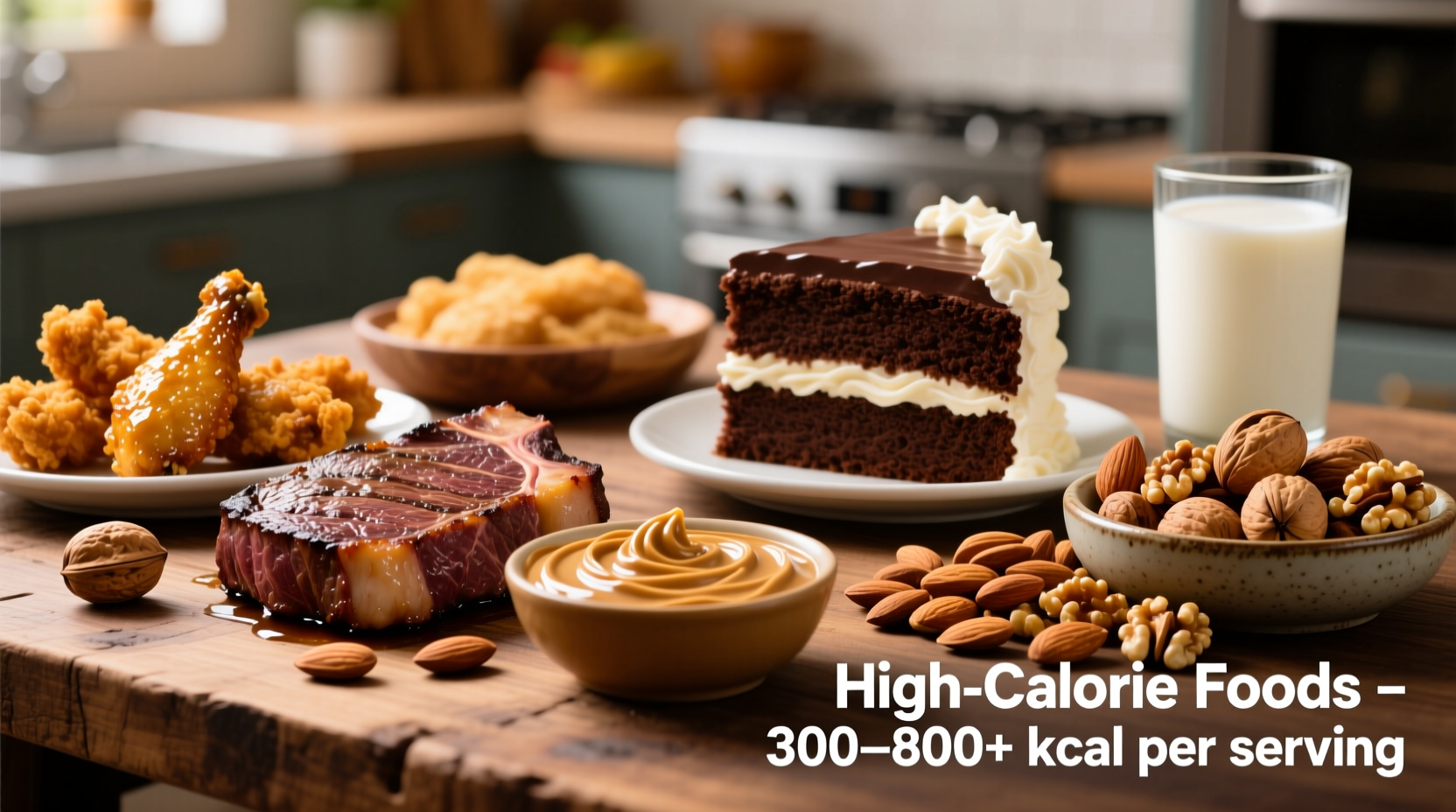When searching for what foods are high in calories, you're likely looking for practical information to support specific health goals. Whether you're trying to gain weight healthily, fuel intense athletic training, or simply understand which foods pack the most energy per serving, this guide delivers science-backed information you can trust. Unlike many superficial lists online, we've organized high-calorie foods by nutritional value and practical application, helping you make informed decisions based on your individual needs.
Understanding Calorie Density: Why Some Foods Pack More Energy
Calorie density refers to how many calories a food contains per unit of weight. Foods high in fats (9 calories per gram) and sugars (4 calories per gram) naturally rank highest. Understanding this principle helps explain why certain foods become calorie champions:
| Macronutrient | Calories per Gram | Common Food Sources |
|---|---|---|
| Fat | 9 | Olive oil, avocado, nuts, seeds |
| Carbohydrates | 4 | Sugars, starches, dried fruits |
| Protein | 4 | Meat, dairy, legumes |
| Alcohol | 7 | Liquors, wines, beers |
This calorie density comparison chart explains why foods rich in healthy fats typically top the list of high-calorie options. According to USDA FoodData Central, pure fats like oils contain about 884 calories per 100g, while high-sugar foods range from 300-400 calories per 100g.

Nutrient-Rich High-Calorie Foods Worth Adding to Your Diet
Not all high-calorie foods deliver equal nutritional value. The following categories represent options that provide substantial energy along with valuable nutrients:
Fats and Oils: The Calorie Champions
Fats contain more than double the calories of carbohydrates or protein, making them naturally high-calorie. The healthiest options include:
- Avocado (160 calories per 100g): Packed with heart-healthy monounsaturated fats and fiber
- Nuts and seeds (550-700 calories per 100g): Almonds, walnuts, chia seeds, and flaxseeds offer protein, healthy fats, and essential minerals
- Olive oil (884 calories per 100g): A Mediterranean diet staple rich in anti-inflammatory compounds
Dairy Products: Calorie-Dense Nutrition
Full-fat dairy products provide both calories and valuable nutrients:
- Cheese (350-400 calories per 100g): Parmesan, cheddar, and blue cheese deliver protein and calcium
- Whole milk (61 calories per 100ml): Contains complete protein and fat-soluble vitamins
- Full-fat yogurt (60-70 calories per 100g): Provides probiotics along with energy
Dried Fruits and Sweeteners: Concentrated Energy
Drying removes water content, concentrating calories in smaller portions:
- Dates (277 calories per 100g): Natural sweetener rich in potassium and fiber
- Raisins (299 calories per 100g): Portable energy source for athletes
- Honey (304 calories per 100g): Contains trace nutrients unlike refined sugar
When High-Calorie Foods Become Essential: Practical Applications
Understanding context boundaries for high-calorie food consumption separates useful information from generic advice. These foods serve specific purposes depending on individual circumstances:
Healthy Weight Gain Strategies
For individuals underweight or recovering from illness, high-calorie nutrient-dense foods are crucial. The Academy of Nutrition and Dietetics recommends adding 500-750 calories daily for gradual weight gain. Rather than relying on processed high-calorie foods, focus on nutrient-rich options like:
- Adding avocado to sandwiches and salads
- Using nut butters as snacks or in smoothies
- Choosing full-fat dairy products over low-fat alternatives
Athletic Performance and Recovery
Endurance athletes require significant caloric intake to maintain performance. According to sports nutrition research, athletes may need 20-30 calories per pound of body weight daily. High-calorie foods help meet these demands:
- Nut butters provide quick energy during long runs or rides
- Dried fruits offer portable carbohydrates for sustained energy
- Trail mix combines fats, carbs, and protein for balanced fueling
Medical Conditions Requiring Increased Caloric Intake
Certain health conditions necessitate high-calorie diets:
- Cancer patients often experience increased metabolic demands
- Hyperthyroidism accelerates metabolism, requiring additional calories
- HIV/AIDS may increase nutritional needs while decreasing appetite
Avoiding Common High-Calorie Food Misconceptions
User sentiment analysis reveals widespread confusion about high-calorie foods. Let's address the most prevalent misconceptions:
| Misconception | Reality | Source |
|---|---|---|
| All high-calorie foods are unhealthy | Nutrient-dense high-calorie foods support health | Mayo Clinic Nutrition Guidelines |
| Low-calorie always equals healthier | Nutrient density matters more than calorie count alone | Harvard T.H. Chan School of Public Health |
| High-calorie foods cause weight gain | Weight change depends on overall energy balance | American Journal of Clinical Nutrition |
This high-calorie food misconception comparison highlights why evaluating foods based solely on calorie content provides an incomplete picture. The Dietary Guidelines for Americans emphasize overall dietary patterns rather than individual food components.
Strategic Incorporation of High-Calorie Foods
Maximize the benefits of high-calorie foods with these practical strategies:
For Healthy Weight Gain
Focus on adding 300-500 extra calories daily through nutrient-dense sources. Try these evidence-based approaches:
- Add one tablespoon of olive oil to cooked vegetables (120 calories)
- Include a quarter avocado in sandwiches or salads (80 calories)
- Snack on a small handful of almonds (160 calories)
- Use full-fat Greek yogurt instead of sour cream (100 calories per 100g)
For Athletic Performance
Time your high-calorie food consumption strategically:
- Pre-workout: Banana with almond butter (300 calories)
- During endurance events: Dates or energy chews (100 calories per serving)
- Post-workout: Smoothie with full-fat milk, banana, and peanut butter (500+ calories)
When to Approach High-Calorie Foods Cautiously
While many high-calorie foods offer nutritional benefits, some provide primarily empty calories with minimal nutritional value. These include:
- Deep-fried foods (doughnuts, fried chicken)
- Sugary beverages (sodas, sweetened coffees)
- Processed snack foods (chips, candy bars)
The key difference lies in nutrient density. Whole food sources of calories typically deliver vitamins, minerals, and other beneficial compounds alongside their energy content, while processed options often lack these additional nutrients.
Creating Balance with High-Calorie Foods
Successfully incorporating high-calorie foods requires understanding your personal energy needs. The National Institutes of Health provides a calorie calculator to estimate your daily requirements based on age, gender, and activity level. This helps determine whether you need to increase, decrease, or maintain your current caloric intake.
Remember that individual responses to foods vary. What works for one person's weight management goals might not work for another's. Consulting with a registered dietitian provides personalized guidance tailored to your specific health situation and goals.











 浙公网安备
33010002000092号
浙公网安备
33010002000092号 浙B2-20120091-4
浙B2-20120091-4